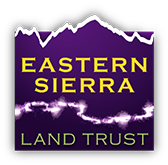Eastern Sierra Land Trust is a nonprofit organization that works with willing landowners to protect vital lands in the Eastern Sierra for their scenic, recreational, historical, agricultural, botanic, watershed, and wildlife values. We work to help families preserve their working farms and ranches in the face of pressures to subdivide their properties. We work to help landowners protect our region\’s plants and wildlife. And we work to preserve natural areas in and around the Mono Basin National Scenic Area.
Founded in 2001, the ESLT is the first and only land trust based in Inyo, Mono, and Alpine counties (see area map). We began our work when private citizens and public officials in our area expressed interest in the development alternatives, mitigations, and habitat protections that land trusts can provide.
In December 2003 we completed our first voluntary land conservation agreements (commonly referred to as conservation easements), in the migration corridor of the Round Valley Mule Deer Herd; the following year we hired our first professional staff. In 2005-2006 we completed land protection agreements to protect 818-acre Montgomery Creek Ranch, keeping its historic water rights forever in agriculture, and to protect important wildlife habitat at Big Hot Springs Ranch on the Highway 395 scenic corridor. Today we’re working to protect other vital lands, including almost 900 acres in agriculture in Benton Hot Springs Valley, and more critical wildlife habitat.
With our newsletter SierraScapes, we are keeping people informed about private land conservation in the Eastern Sierra, and helping people throughout California and the nation embrace our mission to preserve nature and our rural quality of life, in one of the world’s most spectacular mountain regions.
WHAT DOES A LAND TRUST DO?
Land trusts work with private landowners and the public to conserve working farms and ranches, natural areas, and cultural and biological resources. They may acquire lands, or set up voluntary land protection agreements with willing landowners, or mediate land trades between landowners and public agencies. Land trusts have existed for over 100 years; more than 1,660 are operating in the United States. Funded mainly by charitable donations and by private and government grants, these land trusts now conserve more than 37 million acres of land including scenic areas, hiking trails, critical wildlife habitats, farms and ranches, and historic landmarks. Most land trusts operate locally, providing crucial land-use tools for property owners and citizens concerned with conservation on private lands.

